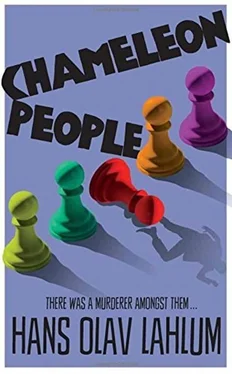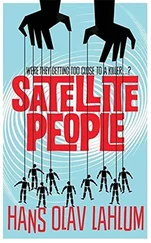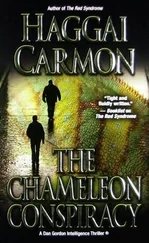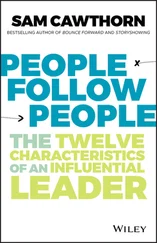Patricia blew on her coffee, then cautiously took a sip. I had the distinct feeling that she was waiting for me to ask her to explain the concept, and had no alternative but to do just that.
‘Goodness, apologies, I was obviously not thinking and used a concept that I made up myself and have since used so much that I forget that it is not generally known. But it is very appropriate and almost self-explanatory. The crime novelist Sven Elvestad based his novel Chameleon on the phenomenon in 1912. A chameleon person is someone who can move seamlessly between different circles and switch appearances depending on where they are.’
‘Surely that is relatively normal?’ I objected.
Patricia wiggled her head from left to right, and carried on speaking.
‘Yes and no. Fortunately, most of us behave slightly differently depending on who we are with and which social setting we are in. It is called social skills. But real chameleon people are different: they can change their face, behaviour and even personality within seconds, depending on what they think will serve their interests. Hauk Rebne Westgaard touched on it when he said that, ever since he was a child, Fredriksen had had many different facets and faces. And in more recent years, he had been perceived very differently as a businessman and a family man. His mistress has another impression of him, and people in political circles yet another. I would like to know more about the latter. Even though it may be painful for them, I think you should ask his family what they know about his earlier mistresses. And bear in mind all the time that several people may turn out to have several faces, and that some of those who do not appear to be dangerous on first meeting could be just that. Chameleons are generally thought of as small, innocuous animals, but they can suddenly change face and swallow their prey when least expected.’
I listened to her, fascinated, and promised to bear it in mind.
‘The boss is very reluctant to give up on the boy on the red bicycle as a possible perpetrator, but it would seem now that it is just a red herring?’ I suggested.
The coffee was no longer steaming. Patricia took another sip and thought for a while before answering.
‘We obviously cannot disregard the possibility that the murder may have something to do with Fredriksen’s life as a callous businessman and a heartless landlord. I think it is highly likely that what your eyewitness saw is true, despite her age, and that the poor boy was innocent. But we should not take that as a given yet.’
‘If the boy was innocent, it seems very odd that he then took the murder weapon with him when he fled to my home,’ I remarked.
Patricia shook her head fiercely. ‘To the contrary, his behaviour there and then is perfectly logical, if you look at what happened in isolation, in the sequence that he experienced it. Imagine how you would react in that situation. You are out in the street and see a man who has collapsed with a knife in his heart. What would you do?’
‘I would run over to see if he was alive. Then I dare say I would pull out the knife,’ I said.
Patricia nodded. ‘Precisely. Pulling out the knife does not in any way improve the victim’s chances of survival, but it is a natural reaction. Then there is the next stage. Fredriksen is clearly dead. The boy is standing there with the murder weapon in his hand and no other suspect in sight. He realizes in a flash that makes him the prime suspect regardless of whether he is caught at the scene of the crime with his fingerprints on the knife, or leaves the knife with his fingerprints on it behind. His life has never been easy and he does not have much self-esteem or trust in society. He does, on the other hand, have absolute trust in his hero, in other words you, and knows where you live. Given that he is both innocent and intelligent, it is then quite rational that he takes the murder weapon with him, jumps on his bike and cycles to your flat. What is confusing, and what makes me hesitate to dismiss him as the perpetrator-’ Patricia stopped in the middle of the sentence and sat there staring into thin air.
‘Once again, you are right. What is confusing is not his behaviour after the murder, but his behaviour after his arrest,’ I said.
Patricia nodded. ‘Precisely. Though to be fair, he did say specifically that Fredriksen was dead when he went back, and he shook his head when you asked him if he had seen the murder. So perhaps he did not have much more to say. The parallels with Hauptmann and van der Lubbe indicate that he was well aware of the situation, despite his communication problems. But his refusal to give his name or other details is very strange and clearly did not help his already difficult situation. There is something irrational about it which could indicate mental disturbance and thus make it possible that he did commit the offence after all. But it was most probably due to shock or an exaggerated belief that you would quickly be able to uncover the truth. Whatever the case, the story of the boy on the red bicycle is so puzzling that we cannot simply write him off as a tragic red herring. However, the most interesting thing is, in fact, not the boy’s reaction, but-’
Patricia stopped speaking and looked very pensive indeed. It was obvious that the cogs in her brain were whirring furiously.
‘But the mother’s reaction?’ I tried tentatively.
Patricia shook her head with what looked like irritation. ‘No, no, given that she had been away for the weekend and did not get back until Monday, that part of the story is believable enough. What I find strange is your boss’s reaction. In part because he is so keen to close the case and put the young boy down as the perpetrator. And in part because he keeps saying that if the investigation is to continue, the focus should be on Fredriksen’s private life and the tragedy in 1932. At the risk of sounding paranoid, I wonder whether Fredriksen’s murder might be like an iceberg, and that we still cannot see the bulk of what is hidden under the surface. There is one thing that could point in that direction, and I do not like it one bit.’
Patricia fell silent again. Then suddenly she drank the rest of her coffee in one go. Then she said five words: ‘The man in the hat.’ She sat deep in thought without saying anything as the seconds ticked by. ‘I would very much like to know who the man in the hat is. If he really is just a passer-by whom you happened to meet twice in the same day, it is all far less dramatic and I wouldn’t fret. However, I do not think that is the case. If he was following you, he could of course be a friend, relative or private detective who is following you on behalf of someone in the Fredriksen family, his mistress, the Ramdals or Hauk Rebne Westgaard. But it would be fairly risky for any of them to ask someone to follow a police detective like that. And what they stood to gain by knowing where you were going is unclear. So I doubt that that is the explanation. In which case, the man with the hat points to something bigger which is still lurking beneath the surface, in possibly rather icy water. Too much importance should not be placed on his missing finger joint, in isolation, but that detail does not make the case any more pleasant…’
Patricia’s hands were shaking ever so slightly when she lifted the coffee cup to her mouth. She appeared to be lost deep in her own thoughts and did not notice that the cup was empty.
‘No, there are far too many possibilities here for me to be able to give you any more help tonight. I need more facts in order to discard those that don’t work. Let me know when you have more. Check the alibis of everyone we have spoken about, ask the family if they know about any of Fredriksen’s other mistresses, follow up his political life, be open to the possibility that your boss is not telling you everything he knows about the case – and meanwhile, take good care of yourself.’
Читать дальше












